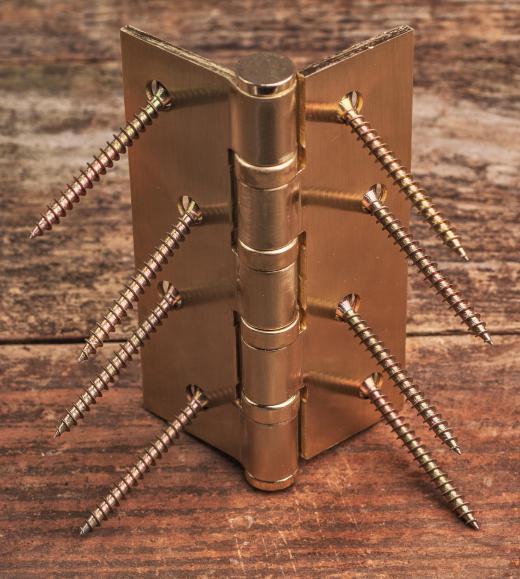A rising hinge is a type of hinge that allows the door to rise slightly off the floor as the door is opened. It is most often used to keep the door from scraping on carpet or uneven flooring. Using a rising hinge can also help a door to close automatically. The rising hinge, or rising butt hinge, is similar to a normal butt hinge. Both are made up of two plates attached together with a pin. One plate attaches to the door, while the other attaches to the wall, and the pin allows the plates to pivot against each other to open and close the door.
The two hinges differ in one key point. On a normal butt hinge, the bevels that allow the plates to pivot on the pin are cut parallel to the floor so that the door opens without changing height. By contrast, the bevel on the rising hinge is cut at an angle, like the stripes on a candy cane, so that as the door is opened it also rises away from the floor.

This rising action allows the door to open easily even if the floor is uneven. It also prevents scraping on plush carpet, where the action of the door opening and closing might wear out the carpet over time. When a door has weather stripping on the bottom, a rising hinge is recommended to keep the door from sticking. A rising hinge will usually raise a door one-half of an inch.

Another use for rising hinges is to help a door close automatically. The weight of the door combined with the angled bevel on the hinge pin will encourage the door to swing shut. This works best if the door hinges are kept well lubricated by oiling them regularly.
When installing rising hinges, a couple of key points should be considered. First, rising hinges are appropriate only for wooden doors because they have to be screwed directly in the door. This type of hinge can usually be separated, meaning that when the door is in the full open position it can easily be lifted up off its hinges.
Rising hinges are not reversible. The rising bevel means that a left hand hinge and a right hand hinge cannot be installed on the same door. Doing so would cause the door to attempt to rise and lower at the same time. The bevel on both hinges should always slope up from the door frame toward the door.
